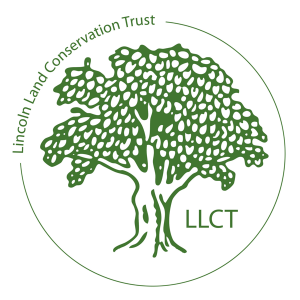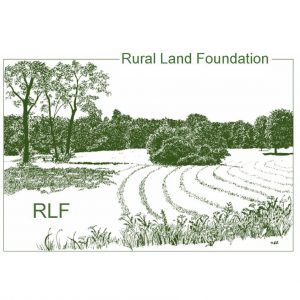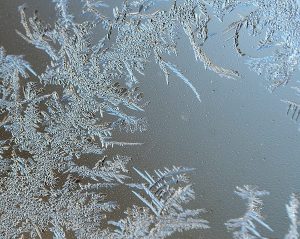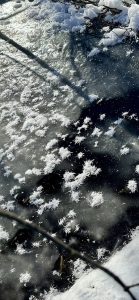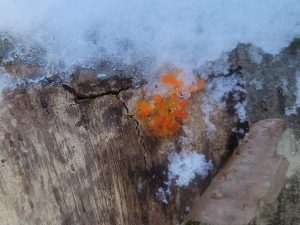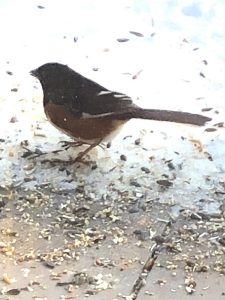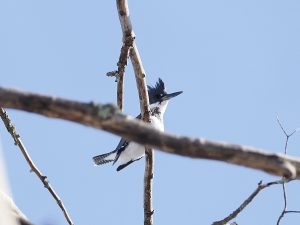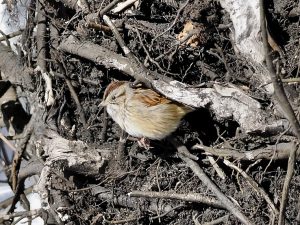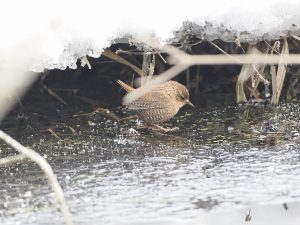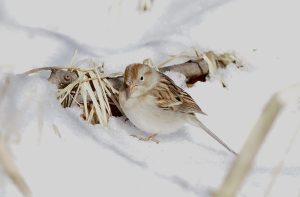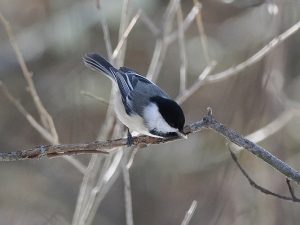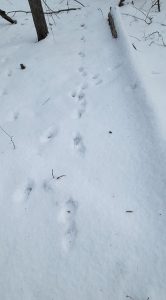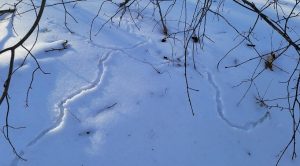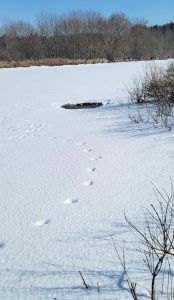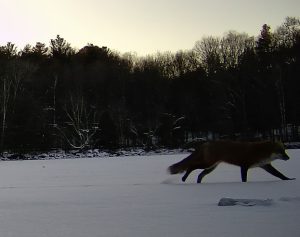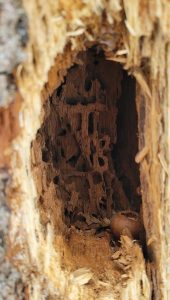Written by Gwyn Loud for the Lincoln Land Conservation Trust. She welcomes your sightings and questions at 781-259-8690 or gwynloud555@gmail.com
On Groundhog Day, February 2, Ms. G, the Commonwealth’s official groundhog, who lives at Drumlin Farm, saw her shadow, thus predicting six more weeks of winter. We may or may not believe this folklore, but there is no doubt that winter has come with a bang this season, after several years without much snow. The plows are busy, the landscape is white, and voles are making subnivian tunnels. As Frances von Mertens writes in her Nature Almanac and Calendar, “ A lot goes on in the subnivian zone where a blanket of snow traps the earth’s radiant heat. A depth of 8” maintains close to 32℉ no matter how cold the world above. Small mammals eat seeds, weeds, insects, and fungi, protected from predators other than owl, fox, or coyote crashing through their cover. A topic of ongoing study: how a warming climate with inconsistent snowpack and freeze-thaw cycles, impacts tree roots and forest growth, nutrient retention, soil organisms, and other denizens of the subnivian zone.”
A lot of treacherous ice, wind, and frigid temperatures have also been part of the scene so far this month. We hope that the water table will benefit when everything melts. Meteorologists explain that the polar vortex is causing this weather: instead of the vortex keeping the cold air in the Arctic, it is stretching like a band, pushing the cold air south into the US. In spite of the wintry weather, signs of spring continue to emerge, and before the next wildlife column reaches your in-box, the sap will be rising in the maple trees.
Those who maintain bird feeders are seeing more numerous customers, as snow and ice are covering ground-level wild food. Most are “the usuals” such as black-capped chickadees, juncos, cardinals, house finches, mourning doves, etc. Starlings can descend and devour suet very quickly, and my peanut-butter log is emptied in a day, enjoyed by bluebirds, woodpeckers, and Carolina wrens, to name a few. I enjoy watching interactions between birds. Who will dominate at the suet feeder: the blue jay or the hairy woodpecker? (The woodpecker won). Many species seem happy to feed side-by side, as a bluebird and junco are doing on a suet cake as I write this sentence. Three people have reported Eastern towhees at their feeding area just in the last ten days, from different parts of town. A few towhees usually over-winter in the area. I’m guessing that these ground-feeding individuals have been finding wild foods in shrubby places, but now the snow and ice are pushing them to seek seeds elsewhere. Two neighbors have seen belted kingfishers recently, which surprised me, as the ponds are frozen. Rakesh Karmacharya wrote about them, “They were active near the stream inlet by the driveway where the water was not frozen…..that “watering hole” was teeming with fish, including one that was about a foot long!” Carol Roede notices that there are always patches of open water in the swamp, no matter how cold, and that the swamp sparrow and winter wren go there everyday. Water is essential for all birds and mammals, so I keep an eye on my bird-bath to make sure the heater is working.
Birds, being warm-blooded, have to have ways to keep warm in frigid cold. One of these is to puff up their feathers, creating warm air pockets and trapping the body heat. Birds also shiver to keep warm, and when perched on a branch, they hunch down, almost covering their feet. For more on the feet, an article in Iowa Outdoor Magazine explains, “The temperature of the feet is close to the temperature of the snow, so very little heat transfers between the two. The feet are just warm enough to avoid frostbite, and the bird’s circulation is fast enough that blood doesn’t remain long enough in the feet to freeze. In severe cold, a bird may stand on one foot, with the other tucked under feathers. This further reduces heat loss by keeping one foot warm, and the surface area in contact with ice or snow is cut in half.” Sometimes birds huddle together to keep warm, or find a protected spot in evergreens or unused bird houses.
Birders at Drumlin Farm continue to find over-wintering species such as hermit thrushes, field sparrows, swamp sparrows, an Eastern Phoebe, and a pine warbler. The lark sparrow, visiting from the West, was still there as of February 11th and an observer saw eighteen bluebirds investigating bird houses. Birds spotted overhead included bald eagles, great-blue herons, turkey vultures, and hooded mergansers. Elsewhere in town, avian sightings included the marsh wren, still wintering in the marsh near St Anne’s Church, a couple of Northern flickers, several Cooper’s hawks, pileated woodpeckers, and many red-tailed hawks.
Male goldfinches molt from olive to striking yellow and black plumage for breeding season; already some are showing hints of the finery to come. Male house finches are looking brighter red, also preparing for courtship. We are hearing woodpeckers drumming their breeding calls, and before the end of this month, red-winged blackbirds will arrive. Their conk-a-ree songs are always a harbinger of spring.
I was surprised to see a chipmunk run across the snow and then dart down a hole a few days ago, on a bitterly cold day. Chipmunks do not hibernate, but spend the winter napping a lot in their underground tunnels, waking to eat stored food and to emerge briefly if we have a mild spell. What made the chipmunk I saw (and saw again in the same spot two days later) pop up when it was 16℉? I’ll never know. Nature is full of mysteries.
This is breeding season for mammals such as beavers, raccoons, foxes, and bobcats, meaning the young will be born in the spring when the weather is warmer and food easier to find. Beavers mate in the water under the ice and bobcats travel great distances in search of mates. If you think you are smelling a skunk this time of year, it is quite likely to to be the urine of a red fox, which smells a lot like skunk spray. As naturalist Mary Holland writes, “The strength of the odor of a fox’s urine…is indicative of the important role urine plays in red fox courtship. Information as detailed as the marker’s sex, age, dominance status, and breeding status is conveyed by scent posts scattered throughout the fox’s territory as well as along its borders.”
Carol Roede’s trail cam has captured photos of gray fox, muskrat, rabbits, weasel, opossum, mink, deer, and bobcat. She sometimes sees deer in a group of 8-10 does and young together, and occasionally a buck sniffing around.
Snow provides excellent opportunities to follow animal tracks. Will Leona, Conservation Ranger, photographed various tracks, and wrote, “I did have one of those “Lincoln is such a special place” moments this morning. I went off trail for a little bit to follow the fisher tracks. All within about 100 foot trek I saw some amazing fisher tracks, a ton of deer and coyote tracks, two beautiful coyotes running through the trees, 3 pileated woodpeckers and two white tailed deer. This was all on the northwestern side of the Flints Pond conservation area. So inspiring!” Will also came across a tree with a hole made by a pileated woodpecker and inside one can see tunnels made by carpenter ants and the remains of an acorn eaten by a squirrel. As he said, “a trifecta”!
We do not see much evidence of insects in winter, but you might see tiny springtails, looking like pepper on the snow. Given the snowy scene and severe cold, it is hard to imagine that in only about month we will be listening for wood frogs and spring peepers!
Links:
To read more about the polar vortex
To see Carol Roede’s trail camera footage of mink
